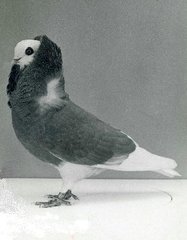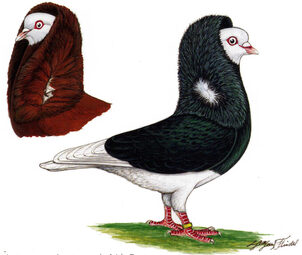Harislau : Utility Poultry & Fancy Pigeons
John S Harrison

The Old Dutch Capuchine
The Old Dutch Capuchine is an ancient breed dating back to the early fourteenth century when it was taken to Holland by Dutch sailors returning from India and the Middle East; it has a long and fascinating history.
In 1967 I first saw the Old Dutch Capuchine on one of my frequent visits to the home of the late Tom Forshaw, well known in the Pigeon Fancy for his interest in, and support of, Rare Variety breeds; what was not realised by most in the Pigeon Fancy was that he was also High Sheriff of Anglesey. The Old Dutch Capuchine had been imported by John Tucker in Somerset the previous year, bringing in birds from the top Dutch breeders L. H. Fles and H. Th. G.Moezelaar.
In his gardens overlooking Red Wharf Bay in Anglesey, just a few miles from my home, Tom Forshaw, or 'Mr Tom', had extensive lofts containing an assortment of rare breeds of Fancy Pigeon, and soon after the breed was imported he had acquired several pairs. 'Mr Tom' was great friends with the Anglesey artist Charles Tunnicliffe RA, and in addition to his collection of pigeons he had a very large collection of Tunnicliffe paintings, including many studies of the Fancy Pigeon breeds he had flying in the garden - one of which was a wonderful painting of red and yellow Old Dutch Capuchines.
Following that visit to Tom Forshaw's I bought a red & yellow pair of Old Dutch Capuchines from John Tucker for the princely sum of £6/10/-, now a mere £6.50 but then half an average weekly wage! Some months later 'Mr Tom' gave me some young Blacks, again from Moezelaar stock ..... “Come over for coffee tomorrow and bring some rings with you"! Several years later when Paul Sabine in Hampshire imported some Blue Bars I bought a pair from him.
 First Old Dutch Capuchine Champion
First Old Dutch Capuchine Champion
Owned & Bred By John S Harrison
In later years I imported a further Red from Henk Moezlaar and a Yellow from L. H. Fles to improve my stock, and despite their value I still allowed them long periods of freedom to fly free in the skies over Anglesey! For many years I corresponded with L. H. Fles who was a source of considerable help, encouragement and advice; from that information, so willingly given, I gained a clear insight into the requirements of the breed as envisaged by the early Dutch breeders.
The first Old Dutch Capuchine to win an NPA Certificate was a Red cock I owned and bred , he was a bird of overall good type and feather quality, but his markings and stance left a little to be desired. In 1973 a yellow cock known as 'Champion Golden Wonder' also owned and bred by me became the first NPA Champion in the breed and twelve months later a yellow hen I also bred which was owned by Barbara Stone became the second NPA Champion in the breed.
Throughout the late 1960's and 1970's the majority of ODC in Britain were Reds or Yellows followed by Blacks, with lesser numbers of Blue Bars and 'Tigers', today around the world it is bred in many more colours.
Since the breed was first shown in Britain it has been renowned for the excellence of colour in the reds, the yellows and the blacks. In 1972 I formed The British Old Dutch Capuchine Society and 37 years later was once again it's Secretary; the other major players in Britain at the time were the original importer John Tucker of Bridgwater, Ralph White from Watchet, Pat Pratt from Marlow, and later Joe Shaw from Manchester.
However, when the breed was first shown in Britain it did not receive universal support, I well remember the very kindly, and well meaning, judge at my first show taking me to one side and advising me that I'd never win with such poor quality Jacobins and offered to give me some better stock ... an offer which I graciously declined! Back in the 1970's I wrote an article "The Old Dutch Capuchine - Jacobin Controversy" on the history and development of the breed which was published in both Britain and America and went some way to quell the vociferous opposition to the breed from those who thought it was little more than a 'bastard form' of the Jacobin!
I gained considerable support from such noteables as Gordon Wood of Penistone, Bill Bishop of Eckington, George Drake of Exeter, and Charles Trevisick FZS of Paignton, but for many months I waged a war of words with the late Jimmy Mundell from Edinburgh. Jimmy was one of the all time greats of the Pigeon Fancy, and an ardent supporter of the Jacobin! The correspondence, both in and out of the pigeon papers, was fast and furious! Jimmy was a grand old man of 92 years and much respected in the Fancy, not least by me, and finally he conceded the point. In a letter dated May 23rd 1973 he wrote “You will recall my views some time back and on reflection I probably did criticise!". Of all the NPA certificates I won with my birds none was more highly valued than the NPA awarded to one of my birds at a show later that year in the old Waverley Market in Edinburgh by none other than Jimmy Mundell.
After an absence from the pigeon fancy for many years except for the occasional judging stint, I restarted with Fancy Pigeons in 2000 and the Old Dutch Capuchine was one of the first breeds I looked to. Sadly I found them to have changed and lost the charm they once had .... for me at least. When several years later I was overstocked I decided to part with a breed so I parted company with them, choosing to keep more Show Rollers and Show Tipplers in their place ......
The Breed Standard
The Breed Standard
for the
Old Dutch Capuchine
Country of Origin :
The Netherlands, circa early 16th Century
Overall Impression :
A graceful, medium small sized pigeon, medium high, with a horizontally carried body. Short, broad between the shoulders, gradually tapering off towards the tail. The horizontal carriage is highly desired. A vertical line dropped from the centre of the eye should locate about 30mm in front of the leg.
Head :
Medium length, well rounded. A flowing skull with rounded forehead. Not "pinch faced". Broad enough at the back to be a sound base for a broad hood.
Eye and Cere :
Iris, pearl white and lively. Ceres of fine texture, red to flesh coloured.
Beak :
Medium in length, with a slight curve at the tip. Flesh coloured in all colours with fine wattles. Set slightly down to a sweet expression.
Neck :
Medium length. Tapering to blend smoothly into the breast and shoulders.
Breast :
Broad and full, carried just forward of the tip of the beak when stood at attention. Throat free from gullet, well cut back.
Back :
Broad between the shoulders, gradually tapering off towards the rump.
Wings :
Not too long, carried well up ie. Lying properly closed on the back and tail terminating about 1cm from the end of the tail.
Tail :
Short rather than long in proportion to length of body. Rather narrow and well closed.
Legs :
Medium in length, shanks and toes unfeathered. Bright red in colour. Thigh feathers not so long as to make the legs look short.
Hood :
Upright and broad, not pinched or "V" shaped, with as many feather layers as possible. Fully feathered down the back of the neck (mane) with no breaks. The mane to blend imperceptibly with the chain below the rosette.
Collar (Chain) :
To run in an unbroken line from the hood to the lower part of the shoulders, to blend with the mane. In no case should the chain feathers from either side meet in the front. They must keep distance from the cheeks and reach up to the lower part of the eye ceres when viewed from the side. On either side of the neck there is an elliptical rosette, set as low as possible.
Colours :
Monk marked in Black, Red and Yellow. All colours to be deep and rich with much lustre and no sign of chequering. Monk marked in Blue with black bars; Silvers with dark dun bars; Mealies with red bars; Creams with yellow bars. Also Self-coloured in White. Tigers in Black, Red, Yellow or Blue. In Tigers the coloured feathers should be evenly interspersed with white. Any other colour are to be entered in the non standard or AOC classes.
Colour and Markings :
Monk marked in the above colours and Self White.
Monk marked :
The head, tail, vent, abdomen & thighs; plus at least 7 and no more than 12 outside flight feathers must be white. There is a straight demarcation line between the white of the abdomen and the colour of the lower breast, this line should be about 30mm in front of the legs. The white of the head must reach up to the base of the hood.
Tigers of any colour are to be entered in Tiger classes. This includes Tortoiseshells and Strawberry tigers which were previously accepted in AOC classes.
Note - Coloured pigeons with odd white feather in the coloured areas or white pigeons with a few coloured feathers are not tigers. If shown at all they should be entered in their respective classes, and penalised accordingly as mis-marked.
Serious Faults :
Hood falling forwards on the head (capping)
Too long and narrow in build
In the region of the eyes, the chain feathers too long obliterating the side view of the eye
Open feathering anywhere on the hood, mane and chain
Poor head markings
Less than 7 and more than 10 Primaries and 2 secondaries flights being white
Slip flighted (coloured feathers in between white)
Eye colour other than pearl white
Visible white wing arch (bastard wing)
Coloured feathers on thighs or on abdomen in front of thighs
Poor colour
Coloured toe nails
Bad carriage, the closer the tail tip is to the floor the worse the carriage.
Minor Faults :
Coloured feathers along the side of the rump and in the vent area
Stained beak
Show Preparation :
As with any marked variety it is permitted to trim or remove offending feathers which spoil the markings. Any trimming must be indiscernible to the judges eye. That is to say any feathers trimmed must be done at the root, not part way down. any bird with feathers incorrectly trimmed or bare areas, should be rejected by the judge, also birds showing signs of illness, dirty, or carrying passengers should be rejected.
Ring size : B
 © John S Harrison
© John S Harrison

The Basic Facts
Origin:
Originally from India
Developed in Holland since 1600
Introduced to Great Britain 1967
Ring Size:
7mm - NPA size B
Specialist Club:
The British Old Dutch Capuchine Society
Est. 1972
Website
Breed Standard:
Link to Club Page

